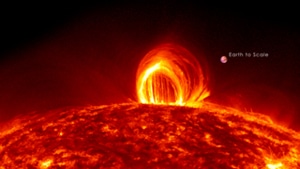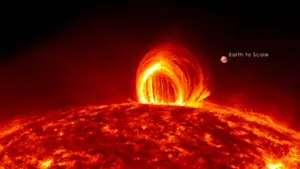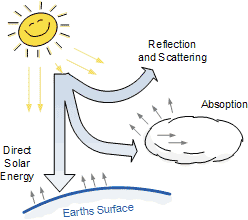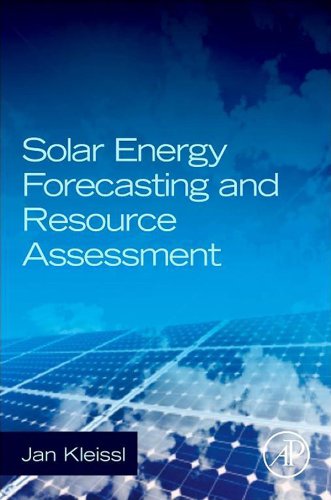
Solar Radiation Energy
Solar Radiation is Solar Energy
![]() We all know that solar energy is a renewable energy resource, and for all practical purposes is free. The technology and equipment we need to harness solar radiation as an energy resource to produce light, heat, power and electricity is well established.
We all know that solar energy is a renewable energy resource, and for all practical purposes is free. The technology and equipment we need to harness solar radiation as an energy resource to produce light, heat, power and electricity is well established.
The sun is the original energy resource and our planet has used the the sun’s light and heat for billions of years to develop and grow. Even our weather is the result of all those complex thermal inter-reactions between solar radiation, the atmosphere, oceans and land surfaces on the sunlit portions of the planet.
Solar Radiation comes from the sun, which itself is a virtually unlimited source of energy. The quantity of solar radiation that the Earth receives each day surpasses by far all of our power requirements combined if we were able to harness it. This immense amount of power we receive daily, called Incident Solar Radiation, or Insolation for short, exceeds more than 100 million times the total amount of energy we use in a single year.
This tremendous amount of energy is free, abundant and almost uniformly distributed and available to everyone around the world. Solar energy is therefore considered renewable and can be converted to other forms of energy by several conversion processes. However, even with today’s use of photovoltaics, solar thermal panels and wind farms, only a very small fraction of this incident light is used by the Earth’s population.

The Earth orbits the sun, which itself is a star, and the time taken to complete one full rotation is a period of one year, which is approximately defined as 365.25 days. But the Earth’s rotation is not a perfect circle as it rotates around the Sun at a slightly elliptical orbit producing the winter and summer seasons.
Also the Earth rotates daily (24hrs) around its polar axis, from the North Pole to the South Pole at a constant inclination of 23.45 degrees to the plane of the elliptical orbit.
These differing vertical and horizontal inclinations and orbits results in seasonal variations of the amount of solar radiation received by the Earth. Then the amount of solar energy received at the Earth’s surface at any given location depends on the altitude, latitude, time of day and year, local weather patterns and atmospheric effects, and orientation of the surface with respect to the sun. This is why the orientation of solar collectors, that is which way they face and how much they are tilted from horizontal, optimizes their solar collection ability.
The sun emits radiation because its surface is hot – just as an electric fire emits light and heat when the element is hot. The solar radiation energy emitted by the sun covers a wide range of wavelengths (corresponding to colours in the visible spectrum) from ultraviolet radiation, through to visible light to near infra-red radiation. Here on Earth, we receive normal light in the visible frequencies and our heat from the infra-red spectrum of frequencies. Then solar radiation is the light and heat received by the Earth from the sun.
The solar radiation power emitted by the Sun is uniform and even in all directions flowing continuously through the Earth’s atmosphere onto its surface. Out in space above the Earth’s atmosphere, every square meter of space receives about 1370 watts (1.37 kilowatts) of solar radiation. This value is called the solar constant, S measured in W/m2.
However, the Earth’s gaseous atmosphere may permit the easy transmission of incoming ultraviolet, visible and infra-red solar radiation but it is also a filter as clouds, particles, water vapour and the Earth’s surface absorb, reflect and scatter some of it back into space.
Solar Radiation through the Atmosphere

Normally solar radiation measurements are taken with a horizontal instrument such as this Solar Radiation Sensor which can measure the net radiation plotted over a whole day. This Davis Solar Radiation Sensor accurately estimates the amount of solar radiation a site will receive and can be used for the siting of PV arrays, solar homes, and solar thermal panels.
Values measured on the surface of Earth are usually lower than the solar constant. This is because as we have mentioned previously, various influences of the atmosphere and Earth’s surface reduces the solar irradiance.
By the time it reaches the ground, the maximum incident radiation of 1m2 of horizontal surface at an equatorial location is close to 1000 watts (1.0 kW). However, when the solar radiation is averaged over the entire day-night cycles and over the whole summer-winter year, even the best locations here on Earth only receive an average of only 250–300 W/m2. That’s less than 30% of what arrives at the top of the atmosphere.
Some of this solar radiation that eventually does get through is further scattered and reflected as it travels down to the Earth’s surface. The scattered radiation that does eventually reach the Earth’s surface is known as “diffuse radiation”. Diffused radiation is generally a weaker form of solar radiation, but nevertheless it can still be used to generate electricity and heat.
The portion of solar radiation that reaches the Earth’s surface directly, having travelled a straight path from the sun without being reflected or scattered is referred to as “direct radiation” and as such is a much stronger form of solar radiation capable of producing more solar power.
The direct radiation incident on a photovoltaic or thermal panel is determined by its incident angle. This angle in turn is dependent on the alignment and the location of the receiving surface and the position of the sun. When the sun is directly overhead, the sunlight has the shortest path to travel through the atmosphere and therefore maximum solar radiation occurs at solar noon. The further the sun is from directly overhead, the more atmosphere the radiation must travel through.
In the early morning or the late afternoon, the position of the sun is at a more horizontal angle to the surface of the Earth so the solar radiation has to travel through more of the atmosphere before hitting a solar panel and the less intense it will be. This is because there is less direct solar radiation and more diffused radiation as a result of more of the scattering process within the atmosphere.
We can also increase the amount of solar radiation energy per unit area by concentration of the scattered or direct solar radiation using lenses or mirrors. But how strongly can the sun’s energy be concentrated?. Unfortunately not all the sun’s rays that reach the Earth surface are precisely parallel to one another for us to concentrate them efficiently onto a single point.
Solar collectors, reflectors and parabolic dishes can greatly increase the efficiency of a system by focusing the sunlight. The concentration factor, also known as the “number of sun’s”, of a concentrating solar collector can be equivalent to more than 1,000 sun’s. However, this is not a good idea with photovoltaic PV panels because you can easily overheat the panels and reduce, rather than increase, their efficiency.
Tutorial Summary
Solar radiation is a powerful source of energy and the economic viability and technical feasibility of solar energy depends upon the amount of solar radiation in the area where we intend to use this form of energy.
Our homes and buildings can be designed to take full advantage of the sun’s solar radiation using its heat and light for our homes.
But before installing a solar power system, it is necessary to know both the demand and the likely solar radiation energy available, together with their variability at any given location. Knowing this and the projected pattern of energy usage, it is possible to calculate the size of panel, collector and storage required.
In addition to the regular variations of summer and winter, there are also substantial irregular variations relating to the day-to-day fluctuations of solar radiation because they affect the amount of energy storage required within a solar energy system.
Then it is apparent that the total amount of solar energy received at any location on the surface of the Earth during a day or during a year depends on several factors and which determine the viability of solar energy are:
- Geographic latitude of the location of the place.
- Average cloudiness or coverage of the location.
- Time of the day and the day of the year.
- Angle of the collector with the horizontal.
- Local landscape and local weather conditions.
The position of the sun relative to a given location is essential for many solar energy systems. The two angles of sun height (solar altitude or elevation) and sun azimuth define the position of the sun and hence the amount of available solar energy.
Solar position or sun-path diagrams can be used to visualize the path of the sun during the course of a day at that location. These sun-path diagrams show sun height and azimuth for every hour of the selected days with a curve drawn through the points giving the suns solar radiation data.
The sun’s energy is free and available to everyone all around the world, and the technologies that turn solar irradiance into usable energy both thermal and PV are dropping in price as the solar industry grows and production increases.
Solar PV panels made for our homes today are more advanced than ever before with the capability of producing electricity even when there is less sunlight. Solar reflectors can convert weaker diffused solar radiation into electricity using mirrors and lenses.
To learn more about “Solar Radiation”, or to understand how the radiation emitted by the sun travels through space to Earth, or just to explore the advantages and disadvantages of solar energy, then Click Here to get your copy of one of the top books on Solar Radiation Energy and the Environment direct from Amazon today.










…But the Earth’s rotation is not a perfect circle as it rotates around the Sun at a slightly elliptical orbit producing the winter and summer seasons. what?
Hello not really, you really have completely missed the point of this tutorial.
It’s my pleasure to conduct a research on sun light radiation
Solar radiation is increasing as we humans damage the atmosphere with green house gases. It may make us feel good when the sun shines but over time the planet temperature will increase, increasing our usage of drinking water.
Solar radiation is good for the skin too, it gives me a good tan for the beach 🙂